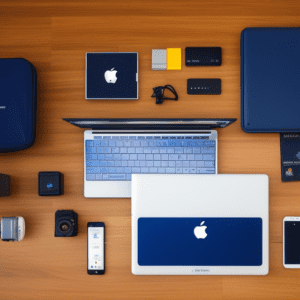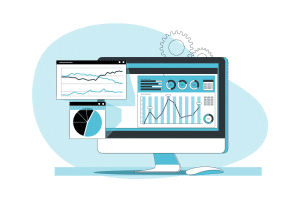5 Essential Steps for Effective IT Asset Management
IT Asset Management is a critical aspect of any organization’s overall IT strategy. Many organizations, however, are not able to achieve their desired IT Asset Management goals due to the lack of a well-defined approach or the right solution. As a result, they often suffer from a high cost of ownership, low asset utilization, and increased security risks. This is why effective IT Asset Management is becoming increasingly important in the current economy. To achieve this, organizations need to follow a set of essential steps to ensure their IT Asset Management strategies are working correctly.
In this blog post, we will highlight 5 essential steps for effective IT Asset Management.
1: Define IT Asset Management
The first key step in effective IT asset management is to define exactly what it means. IT asset management is a comprehensive approach to managing both software and hardware assets, from procurement to disposal. It involves tracking, maintaining, and optimizing everything from servers and workstations to software licensing and warranties. However, the exact definition of IT asset management can vary depending on the organization. Each organization may have its own unique approach to managing its IT assets, based on factors such as industry, size, and budget.
IT Asset Management (ITAM) is a set of processes that help organizations manage their IT assets throughout their lifecycle. The first step to effective ITAM is defining what assets need to be managed. This can include hardware, software, and mobile devices.
Software is no longer considered as simply applications installed on a computer. Now it includes:
- Corporate web, internal, applications
- SaaS applications that the company provide. (Office365, Salesforce, Google Workspace etc.)
- SaaS subscriptions, paid or free, to which a user or department have subscribed
By defining what IT asset management means to your organization, you can begin to develop strategies and policies that are tailored to your specific needs. This will help ensure that your IT assets are properly managed and utilized while preventing unnecessary expenses and security risks.
Wikipedia definition of IT Asset Management, external link.
2: Establish IT Asset Management Policies
Establishing ITAM policies is crucial to ensure all employees understand the processes and procedures to be followed. These policies should outline the roles and responsibilities of IT and non-IT staff in the asset management process. The policies should also include guidelines for the procurement, maintenance, and disposal of IT assets. Effective ITAM policies help organizations improve their IT security and streamline their operations.
Now that you have a clear understanding of what IT asset management is and why it’s important to your business, it’s time to establish policies and procedures that will govern how IT assets are handled. The purpose of creating policies is to ensure consistency, accountability, and compliance, and will act as a guide to ensure that all processes and procedures align with your business objectives.
Some best practices to consider when establishing IT asset management policies include:
- Identifying who will be responsible for asset management
- Defining the lifecycle of assets
- Outlining procedures for handling and disposing of assets
- Ensuring regulatory compliance
IT asset management software can help automate some of these policies and provide greater visibility into asset usage, allowing you to optimize your IT assets and reduce risk. By establishing strong policies and procedures early on, you can ensure that IT asset management is a seamless and effective process for your business.
3: Identify IT Assets
Identifying IT assets is the first step in the ITAM process. This step requires an inventory of all IT assets in the organization. The inventory should include hardware and mobile devices. This helps organizations track what assets they have and where they are located. It also helps to plan for future investments and upgrades.
 In order to effectively manage IT assets, it is essential to first identify them. This may seem obvious, but many organizations struggle with this step due to the complexity and variety of IT assets. To begin, it is important to create an inventory of all hardware (Hardware Asset Management), software (Software Asset Management), and other IT resources used throughout the organization. This can be done manually or through the use of IT asset management software.
In order to effectively manage IT assets, it is essential to first identify them. This may seem obvious, but many organizations struggle with this step due to the complexity and variety of IT assets. To begin, it is important to create an inventory of all hardware (Hardware Asset Management), software (Software Asset Management), and other IT resources used throughout the organization. This can be done manually or through the use of IT asset management software.
Once the inventory is complete, it is important to establish a naming convention and categorize the assets based on their importance, usage, and lifespan. This will allow for better tracking, budgeting, and planning for asset replacement or upgrades.
Another key aspect of identifying IT assets is understanding their location and who is responsible for them. This will ensure that assets are properly managed and maintained, reducing the risk of loss, damage, or theft.
By taking the time to accurately identify IT assets, organizations can better manage their resources throughout their lifecycle and help to reduce costs and improve overall efficiency.
4: Implement IT Asset Management Solutions
Implementing ITAM solutions involves selecting and deploying the appropriate software tools to manage your IT assets. There are many ITAM software solutions available, such as SmartCenter™, that can help organizations automate processes, track usage, and maintain compliance. It’s important to evaluate different software solutions before making a final decision to ensure it meets your organization’s requirements and budget.
After identifying all the IT assets, the next step in effective IT asset management is to implement appropriate solutions. These IT asset management solutions ensure optimal utilization, traceability, security, compliance, and cost-effective management of IT assets throughout their lifecycle. IT asset management software can help automate the task of tracking the location, status, and configuration of assets, enabling organizations to take informed decisions based on real-time data. The software can also generate detailed reports, helping organizations to monitor asset utilization, maintenance schedules, warranties, and licenses.
Integrating asset management with other IT management systems, such as helpdesk, procurement, DEX solutions, and security systems, can further enhance cost savings and productivity. Enabling self-service asset requests and approvals can also improve user satisfaction and reduce administrative workload.
Following IT asset management best practices, organizations should also establish guidelines for IT asset disposal and decommissioning to minimize risks of data breaches and environmental damage.
By implementing these IT asset management solutions, organizations can mitigate security and compliance risks, ensure maximum ROI, and streamline their IT operations.
5: Monitor and Improve IT Asset Management Services
The final step in effective IT asset management is to constantly monitor and improve your services. By doing so, you will be able to identify areas that need improvement and take steps to ensure that the IT asset management process is running smoothly and efficiently. One of the most important ways to monitor and improve IT asset management services is to regularly review your policies and procedures. This may involve conducting audits and assessments of your IT assets to ensure that they are being properly managed and tracked.
In addition to monitoring your policies and procedures, it is important to keep up with the latest trends and best practices in IT asset management. This may involve attending conferences and seminars, reading industry publications such as the Almaden Blog, and collaborating with other IT professionals.
Ultimately, the key to effective IT asset management is to remain vigilant and proactive. By taking the time to regularly monitor and improve your services, you can ensure that you are providing your organization with the best possible IT asset management solutions.
Conclusion
In conclusion, effective IT asset management is essential for organizations looking to optimize their IT operations and reduce costs. By following the five steps discussed in this blog post, you can establish a solid foundation for managing your IT assets and ensure that your organization is functioning at its peak. Whether you choose to leverage IT asset management solutions, such as SmartCenter, or develop your own best practices and policies, the key is to stay organized, informed, and up-to-date.
More than simply IT Asset Management
 Stay ahead of the curve by prioritizing IT asset management, and your organization will reap the benefits for years to come.
Stay ahead of the curve by prioritizing IT asset management, and your organization will reap the benefits for years to come.
An example of this is how SmartCenter information regarding software approval and asset details is pulled through into Collective IQ®, our Digital Experience Management Solution.
Collective IQ®, Essentials Edition, is included as part of CIQ SmartCenter™ at no additional charge. This enables our users to go beyond IT Asset Management and start to experience the benefits of Digital Experience Management (DEX).




